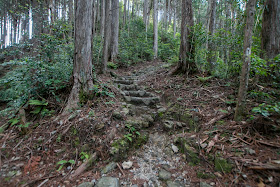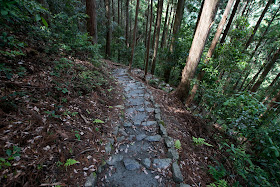Explanation on three types of Japanese castles
As describe in explanation on each castle, Japanese castles are roughly classified into the following three types:
1.
Mountain Castles
Mountain castles are usually built on the
mountains 200 meter to 500 meter high from the foot. In Kamakura era, soldiers
usually build their fort on plains, but in the time of disturbance among
Nanbokucho and beginning of Muromachi era (14th century), local
lords built or transformed mountain temples into castles on steep mountains for
defense. At first they only shaped the terrain and just made fences, but subsequently
structure of castles became more secured by digging moats and building sand walls.
The advantage of mountain castles is its suitability for defense. The path of offence force is usually limited to narrow roads or ridges, and difference
of height was a disadvantage for attackers using arrows and spears.
On the other hand, disadvantage of mountain castles is its inconvenience. It was too hard to live on the mountain long time, thus usually dwelling houses were built at the food of the mountain. Also, the distance between castle and town was not suitable for administration in peace time.
In addition to this, the matter of space
became a problem later. Due to a limitation of terrain, mountain castles
usually had only narrow areas. Butt in the latter half of Sengoku era, warlords
became more organized and siege castles with numerous soldiers. In such
situation, with the limited soldiers and foods kept in castle, it became
significantly difficult to defend mountain castles long time.
For example, Gifu castle which was said as
a secure castle rejected many attacks, just before the battle of Sekigahara at
1600, could not stand one day against large force of Tokugawa army. Moreover, owing to spread of matchlock gun,
difference of height became not important disadvantage for attackers any more.
Due to such reasons, mountain castles were
abolished toward the end of Sengoku era. Only several castles were absurdly reformed
in modern castle with stone walls and used until the end of Edo era.
Examples:
Gifu castle (Gifu prefecture), Iwamura castle (Gifu prefecture), Takatori castle (Nara pefecture), Bicchu Matsuyama castle (Okayama prececture), Tottori castle (Tottori prefecture), Odani castle (Shiga prefecture) etc.
2.
Hill castles
Located on the small hill, usually within 100 meters high from foot. Hill castle have advantages of both mountain castle and plain castle, it means secure defense and usability. Additionally, hill castles can clearly show the order of social standing, between lords, samurais and townspeople. Because of this, hill castles had been built throughout Medieval and Sengoku era.
But once cannons were brought to Japan in
the late of 16th century, buildings on a small hill became a good target
for cannons. Because Japan became peace before critical spread of cannons, this
problem did not come to surface.
Examples:
Himeji castle (Hyogo prefecture), Sendai castle (Miyagi prefecture), Fukuoka castle (Fukuoka prefecture), Wakayama castle (Wakayama prefecture), Matsuyama castle (Ehime prefecture), Hikone castle (Shiga prefecture) etc.
3.
Plain castles
As above, dwelling place of lords in
Kamakura era was built on plain surrounded by single moat. After that, of
course in plain area castles continued to build on flat land.
In the final period of Sengoku era, it was
possible for large and organized warlords to perform a large scale engineering
such as digging moats and building stone walls (At last, it became difficult to distinguish hill castle located on low hill from plain castle with high stonewalls). Even if located on flat land, castles surrounded by multiple
water moats and tall stone walls had sufficient ability of defense, and it was easy to
expand plain castles to store large number of soldiers and supplies in case of war.
In addition to this, plain and wide shape had cannons difficult to aim the buildings in central areas, same as western fortress. Due to this, plain castles became major among the new castles build on and after 1590’s, especially for Tokugawa clan.
In addition to this, plain and wide shape had cannons difficult to aim the buildings in central areas, same as western fortress. Due to this, plain castles became major among the new castles build on and after 1590’s, especially for Tokugawa clan.
Examples:
Edo castle (Tokyo metropolis), Osaka castle (Osaka prefecture), Nagoya castle (Aichi prefecture), Nijo castle (Kyoto prefecture), Aizu Wakamatsu castle (Fukushima prefecture) etc.



















































































































